Chickens peck each other to the blood: reasons and solutions
The phenomenon of pecking, which turns into cannibalism within the bird herd, is a fairly common event. It can be provoked by a huge number of reasons.
Once it has arisen, the fact of aggression is capable of changing the forms of its manifestation and has a high probability of spreading to all livestock. For example, if the root cause of deviant behavior was chicks biting into the paws, which is quite common in young animals in the process of fighting for food, over time, the violation can manifest itself in the head and ridge region. Experts associate this behavior with the process of establishing hierarchy in the community. The danger of the phenomenon of pecking of each other by chickens is not only the reproduction of aggressive behavior of the most violent chicks by calm individuals, but also a high probability of causing severe damage to the external and internal organs of the bird with a subsequent transition to cannibalism.
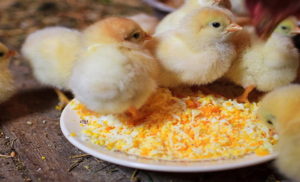
Content
Why chickens peck each other: possible causes
Studying the phenomenon of pecking, experts note some characteristic features of pathology, including:
- The occurrence of a violation stronger and healthier individuals are initially affected, however, in the absence of timely intervention, the pathology spreads to the entire herd.
- Cannibalism prone both adults and chickens. Experienced breeders have noticed that the time interval during which signs of disturbance appear varies from 3 to 5 weeks from the moment of birth.
- Most often aggressive behavior is demonstrated breeds such as egg crosses and broilers, at the same time, farmers note a high sensitivity and a quick reaction on the part of these breeds in relation to the stimulus acting on them.
Note! When studying the relationship between breed and propensity for aggression, scientists have found a strong correlation between color, age, sex of chickens and the frequency of manifestation of rage. According to their data, laying hens and birds of a meat direction have a more nasty character compared to breeds of other shades, and males are less prone to manifestation of aggression compared to females.
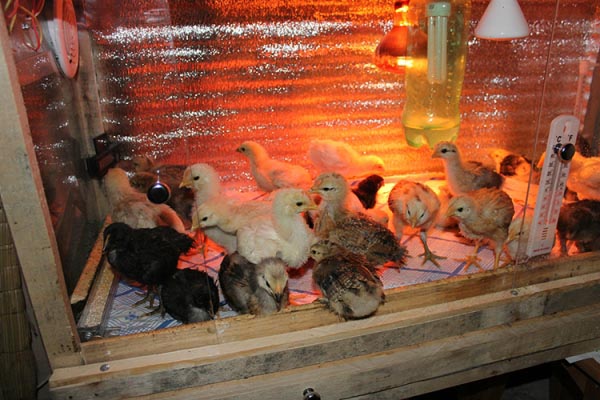
- The described features appear in case of overcrowding in the hen house, an incorrectly balanced diet, changes in the temperature, humidity and light conditions in the hen house. Experts emphasize that the appearance of pathology is incorrect to qualify as a disease in chickens, since it is based on behavioral motives. In any case, in the absence of a timely response from the breeder and the elimination of the cause that caused the chickens to bite each other, as a result of the biting, there is a high probability of damage to the integument to blood, after which the internal organs and cannibalism may quickly spit out.
Why do chickens peck each other until they bleed?
Among the reasons that cause the onset of pecking in chickens, as in adult chickens, farmers call:
- accumulation of a large number of individuals on a unit of free areawhich induces aggressive behavior as it provokes competition for access to food and drink. In the event that a violation is observed when walking poultry, breeders recommend adding juicy feed and grass to the bird's diet. The first signs of aggressive behavior associated with a lack of territory, some individuals show at a very young age when kept in a box. In the future, the presence of a large number of neighbors in cramped conditions has a negative effect on the chicken's nervous system, which manifests itself in a deterioration in behavior and the appearance of outbursts of rage. An overly dense planting of chicks contributes to a deterioration in the microclimate of the room, provokes a slowdown in growth in young animals.
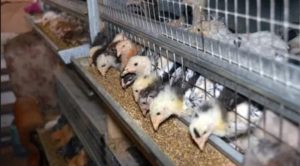
Note! According to the regulations, the area norms for one chick must be at least 120cm2under 21days, 200cm2when kept up to 2.5 months and 330cm2 when growing chickens up to 17 months. - Deviations from normal chick behavior may result from increase in room humidity above the recommended optimum values. The deviation of the microclimate indicators in the direction of decreasing from the rational parameters also has a negative effect, since it leads to drying out of the skin and breaking of feathers. Feeling discomfort, the chick presses on the coccygeal gland, resulting in irritation in the affected area, which is a bait for aggressive individuals.
Important! In addition to humidity, experts note the effect of increasing dust levels in the premises on the increase in the incidence of rage in chickens.
- Increased aggression levels may be associated with with temporary changes in the conditions of keeping chickenscausing a stressful situation, manifested in behavior change.
Note! As triggers causing such a reaction, experts call a breakdown of night lighting, a malfunction of the ventilation system, the presence of strangers in the hen house, for example, workers, and the noise they make.
- The increase in the level of aggression is promoted byviolation of the recommended ratio of males in the hen house.
- Increased rage episodes may be related to improper organization of lighting in the chicken coop. During laying, farmers provide the hens with powerful lighting with lamps, but under certain conditions, additional lighting provokes an increase in the amount of protein, linoleic acid and the consequences associated with the removal of eggs from the oviduct. The likelihood of such a situation increases if, by the time of laying and the appearance of primary plumage, the birds did not have time to gain sufficient weight.
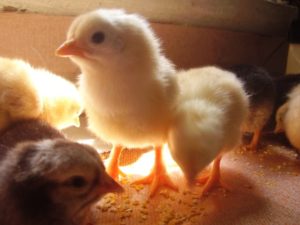
- One of the most common causes of pecking in chickens is imbalance of vitamins and mineralsentering the body of the bird with food. Experts note an increase in the number of cases of cannibalism when feeding chickens with a diet based solely on plant products. However, most often the phenomenon of pecking is associated with a lack of calcium in the body of chickens, which takes part in ensuring the vital activity of cells and the production of necessary enzymes.
Important! In order to avoid a deficiency of components necessary for growth during the change of fluff to feathers, which occurs at the age of about 1 month, it is necessary to provide a sufficient amount of protein in the diet. But the excess of the mass fraction of corn and soybeans over 35% poses a danger of pecking.
- Sudden dietary changes, reduced salt intake or limited chicks' access to water can also provoke a violation of the behavior of young animals. At the same time, experts note the persistent nature of the deviation, which is difficult to correct even when switching to a balanced diet. Among other factors associated with nutrition and causing deviations in behavior, experts call the untimely elimination of dead chickens, the eating of dead chicks by layers and chickens, the presence of injuries and injuries on the skin of the chickens, provoking pecking by relatives.
- Using whole grains in the diet increases the likelihood of pecking, since they are assimilated over a longer time, as a result of which the chick, feeling hungry, can attack a neighbor.
Other reasons that cause rage in relation to congeners in chickens include the presence of skin parasites among the aggressors, high temperature in the room or sudden changes in degrees during the day, the habitation of birds in the chicken coop of different kinds with the "owners" of the breed.
Video: why chickens peck each other
Problem solving methods
What if the chickens peck each other until they bleed?
To effectively eliminate the pathological phenomenon, the farmer must be able to accurately determine the cause that caused the appearance of deviant behavior. Experts identify the following types of damage as:
- Damage head, crest or earring area associated with the establishment of hierarchical relationships in the livestock.
- Defeat in the back and wings, a decrease in plumage associated with their tearing out by relatives is explained by the presence of parasites or a lack of nutritional components in the composition of the feed during the period of changing down to feather. That is why chickens pluck each other's feathers.
- Damage paws in chickens, it is associated with the struggle for food, which occurs when the chicks are overcrowded in a small area.
- Defeat tailbone area associated with insufficient food, the use of uncrushed grain, damage to the oviduct in layers associated with inflammatory processes in it, or the formation of eggs of too large a size.
Having determined the cause that caused the appearance of the pathology, the breeder, taking up the solution to the problem, can use such methods of dealing with biting in chickens as:
- adding chickens to the diet foods with sufficient amounts of calcium, minerals and vitaminscontained in ash, shell, sand, charcoal, chalk, dairy products with medium acidity. Some farmers practice adding feed mixtures balanced in the composition of minerals and vitamins to the diet of chickens, among which such preparations as Movisel, Raskleva.net and others are well-reviewed.
- From 1.5 weeks after birth, it is necessary ensure that a sufficient amount of protein is supplied to the growing body of the bird, and in addition to corn and soybeans, crushed waste of meat and bone and fish industries should be added to the diet of birds. At the age of 1 month, pre-chopped parboiled peas, containing a large amount of protein compounds necessary for a growing body, can be added to the diet of chickens.
- In order to avoid the growth of tension in the herd, it is recommended to ensure daily walking of the livestock, in this case, it is recommended to scatter chopped cabbage, carrots and beets in the designated area.
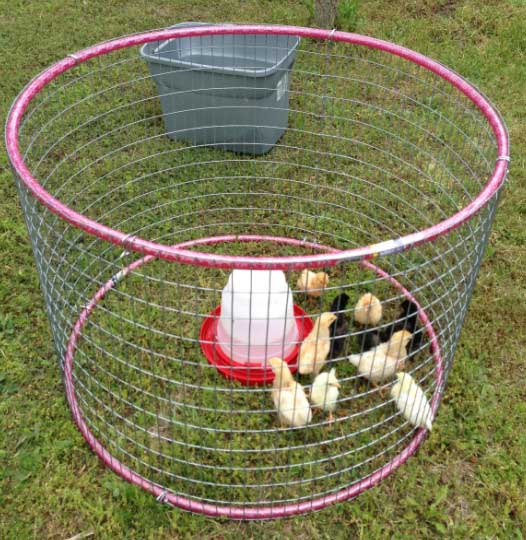
- In order to avoid the onset of aggression between small chicks, it is recommended that grind grain before pouring it into the feeders.
- Experienced farmers recommend that a good way to reduce flock rage is adding apple cider vinegar to the diet in the amount of 3 tablespoons / l of water or feed sulfur, added based on the ratio at the tip of a knife / 1 kg of feed.
- Ensuring sufficient free space for 1 chick is done by resettlement of livestock, separation of the most aggressive representatives from the main group.
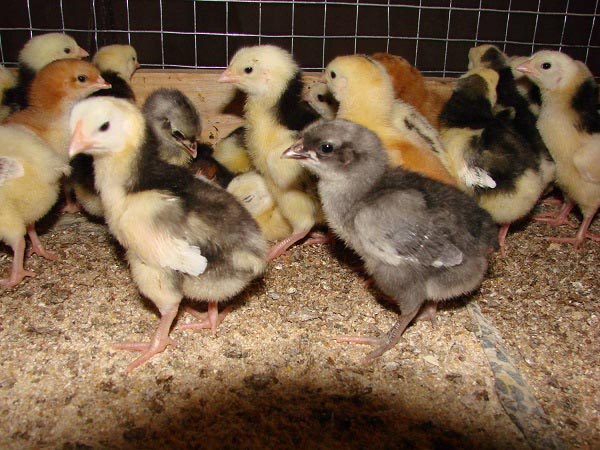
- Reducing the degree of illumination of the room for keeping chickens, up to complete blackout with the light on only for the feeding period. The implementation of such a measure should continue until the complete disappearance of cases of cannibalism in the herd. To simultaneously ensure the microclimate of the room and the flow of light into the chicken coop, you can use infrared light sources or lamps with red lamps, hiding traces of fresh abrasions.
- One of the most radical ways to eliminate the phenomenon of pecking in chickens is de-picking, the essence of which is to remove the sharp part of the tip of the beak. This operation is carried out using a special thermal knife heated to a high temperature, by pressing the beak against their hot surface at an angle of 45 °. The disadvantage of this procedure is the limited time possible for the procedure, which is performed during the first 11 days of the chick's life. Among the characteristic features of the procedure, supporters of its implementation note the painlessness of the operation, ensuring calmness and absence of damage in the herd, reducing the quantitative loss of products associated with their scattering.
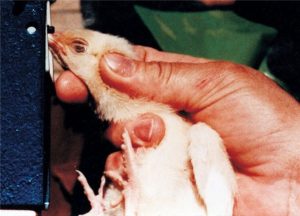
Experts emphasize the importance of observing certain conditions to ensure a successful de-picking outcome, including: excluding the procedure for weakened individuals, performing the operation in a cool time of the day with the involvement of competent specialists, depriving the chicks of food 6 hours before the operation. The standards also stipulate the conditions of the microclimate of the chicken coop after de-picking, among which the breeders call the provision of sufficient food for the young when placing the feeders at a height not exceeding 40 mm, control over the level of illumination of the room and the amount of water available for the chicks. Incorrect performance of the procedure can cause pain during the later life of the chick, lead to an increase in its aggression, the formation of growths on the surface of the beak that impede the intake of water and food.
Video: pecking in chickens, what to do
First aid to chickens when biting
If a chick is found attacked (pecked) by more aggressive congeners, it is necessary to take a number of priority measures to ensure the chick's recovery. Among such events, experts call:
- isolation of attacked individuals from the rest of the herd.
- exclusion of further damage to chicks, provided by applying to the surface of the skin of the injured individual a masking composition with disinfecting properties, for example, a solution of potassium permanganate, birch tar, baneocin, brilliant green, synthomycin emulsion. To reduce visibility in the color vision spectrum of hens, it is recommended to change bright lighting to calm colors of cold shades, such as blue.
- treatment of damaged areas, carried out by treating the surface of the wound with a solution based on chlorhexidine. After that, the damaged surface is lubricated with a mixture of toothpaste with streptocide in the form of a powder or Metrogyl in the form of a gel.
- security keeping the chick on a bed of wood chips or cloth for the recovery period. The possibility of finding a wounded chick on sawdust or straw should be excluded, since in this case there is a high risk of infection if the wound is contaminated from the listed types of bedding.
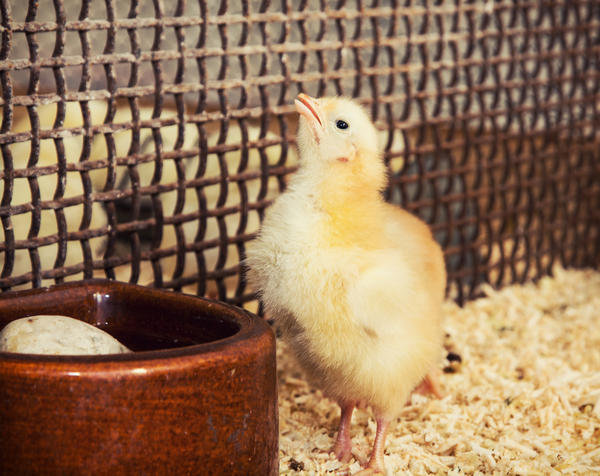
To speed up the process of wound healing, it is recommended to add to the diet of individuals affected by aggression with food containing sulfur and citric acid.
Preventive measures for pecking in chickens
In order to prevent pecking in chickens, experienced farmers recommend taking a number of preventive measures, to which they include such actions as:
- adding to the diet of chicks feed containing substances with abrasive properties, which, with daily use, will ensure a gradual dullness of the beak and reduce the likelihood of deviations;
- it is recommended to exclude keeping individuals of different ages, colors and sex in the same chicken coop;
- if new chicks need to be introduced, the best time for this is evening hours.
However, the most effective measure to prevent biting in chickens is compliance when keeping birds recommended zootechnical and sanitary-veterinary parameters and feeding conditions for young animals.
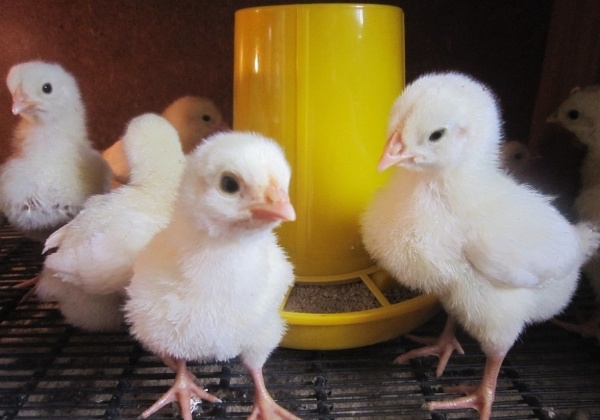
The phenomenon of pecking in one form or another is encountered by a significant part of breeders engaged in breeding chickens. It is critically important to timely notice damage to the integrity of the skin of the injured bird, to ensure the isolation of the aggressor and the injured chick in different places. After finding out the reason for the deviant behavior in the herd, it is necessary to adjust the feeding and housing conditions to optimal parameters. At the same time, it is important to promptly provide first aid to the wounded chick and take preventive measures to prevent the spread of destructive behavior patterns to the entire herd.

